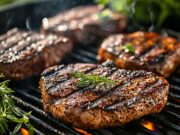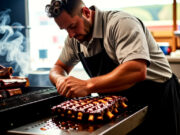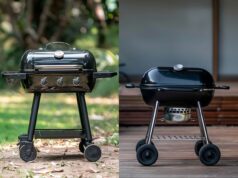If you are new to the world of smoking meats, an electric smoker may be the ideal choice for you.
Unlike traditional smokers, electric smokers provide ease of use and consistent results, making them particularly suitable for beginners.
This guide outlines the essentials—from setting up your smoker and selecting the right meats to mastering temperature control and post-smoking techniques.
Whether you aim to impress your friends at your next barbecue or enjoy deliciously smoked dishes at home, you will find all the necessary tips to get started.
Key Takeaways:

- An electric smoker is a convenient and easy-to-use option for smoking meats, with distinct differences from traditional smokers.
- Proper preparation, including selecting the right meat and wood, preheating, and temperature control, is crucial for successful smoking with an electric smoker.
- Cleaning and maintaining your electric smoker is essential for prolonging its lifespan and mastering the art of smoking meats. Don’t be afraid to experiment and have fun with the process!
Getting Started: What You’ll Need
Before you begin using an electric smoker, it is essential to gather the appropriate tools and ingredients to ensure a successful smoking process.
Key items to consider include quality smoking woods, which play a critical role in imparting unique flavors to the meat, with each wood type offering different taste profiles. A reliable meat thermometer is vital for ensuring that the meat reaches its ideal internal temperature, thereby preventing overcooking or undercooking. Additionally, having an assortment of seasonings, such as various dry rubs, will enhance the overall flavor by complementing the smoky essence.
Together, these tools will enable you to create moist, tender meat with a delightful smoky finish, ensuring that your smoking experience is both enjoyable and delicious.
Setting Up Your Electric Smoker
Setting up your electric smoker correctly is essential for achieving effective temperature control and optimal smoke quality during the cooking process.
By following a straightforward guide based on the manufacturer’s manual, you can significantly enhance your smoking experience. Start by placing the smoker on a stable, level surface, ensuring it is positioned away from any flammable materials.
Next, inspect the components to confirm that the electrical connections are secure and that the water pan is clean and adequately filled. This pan not only adds moisture to your food but also plays a vital role in stabilizing the cooking temperature.
Once everything is properly set up, power on the unit and adjust the temperature settings as outlined in the manual. Regularly checking the temperature with a separate thermometer will help ensure accuracy, allowing you to enjoy the best flavors in your smoked dishes.
Choosing the Right Meat and Wood
Selecting the appropriate meat and wood is crucial in the smoking process, as it directly influences the flavor and quality of the smoked meat. Careful consideration of these elements will ensure optimal results and enhance your overall smoking experience.
Types of Meat Ideal for Smoking

When selecting meat for smoking, certain types are particularly well-suited for the process, ensuring delicious results.
Brisket, for instance, is a favorite among barbecue enthusiasts due to its rich flavor and its ability to absorb smoke, resulting in tender, juicy slices. Pork ribs, with their abundant marbling, excel when smoked; the fat renders down to create a mouthwatering, succulent experience. Smoked chicken provides a lighter option, allowing the delicate flavors to blend beautifully with the smoky essence.
Each of these meat types not only highlights the unique depth that smoking brings but also offers a diverse range of flavors and textures that can elevate any gathering. By choosing the right cut, you can ensure a barbecue experience that is nothing short of extraordinary.
Wood Flavor Profiles
Different types of smoking woods contribute uniquely to the flavor profiles of your smoked meat, making wood selection a critical aspect of the smoking process.
For instance, mesquite offers a bold and robust flavor that can easily dominate the palate, making it an excellent choice for beef dishes. On the other hand, hickory provides a well-rounded, smoky sweetness that complements a variety of meats, including pork and chicken. Understanding the distinct characteristics of these woods is essential for crafting a balanced smoke flavor that enhances the meat’s natural taste without overpowering it.
Enthusiasts often experiment with wood blends to achieve a harmonious mix of smoky nuances, ensuring that each bite is a delightful experience that showcases the meat’s inherent qualities.
Preheating and Temperature Control
Preheating your electric smoker is a critical step that establishes the foundation for successful smoking by stabilizing the cooking temperature and minimizing temperature fluctuations.
A properly preheated smoker ensures more even heat distribution, allowing meats and other foods to start cooking at the correct temperature as soon as they are placed inside. This not only enhances flavor but also plays a vital role in food safety.
Consistent temperature control is essential throughout the smoking process; therefore, utilizing an accurate thermometer is advisable to monitor both the internal temperatures of the smoker and the food itself. Ideally, the smoker should maintain a steady temperature during the process, with occasional checks to prevent fluctuations that could compromise the quality and safety of the smoked dish.
Smoking Your Meat: Techniques and Tips
Mastering various smoking techniques is essential for achieving moist meat with a rich smoky flavor that will impress your guests.
By honing these skills, you can elevate your culinary offerings and create a memorable dining experience.
Using a Water Pan for Moisture

Incorporating a water pan in your electric smoker can significantly enhance moisture retention, resulting in succulent smoked meat. This essential tool serves as a reservoir for hydrating steam and elevates the overall smoking experience by ensuring that your meat remains tender and juicy throughout the cooking process.
As the heat radiates from the smoker, the water heats up and transforms into steam, creating a humid environment that prevents dryness. This aromatic steam not only keeps the meat moist but also infuses it with delightful flavors from the wood chips used during smoking.
Ultimately, utilizing a water pan is a simple yet effective technique that can transform your smoked dishes, making them more flavorful and enjoyable.
Understanding Smoking Times
Understanding the appropriate smoking times for various meats is crucial for achieving the desired flavor and texture during the cooking process.
Whether you are preparing brisket, pork ribs, or chicken, each type of meat requires careful attention and precision. By utilizing a reliable meat thermometer, you can accurately monitor the internal temperature, ensuring that the food is not only perfectly cooked but also safe to consume.
For example, brisket generally requires smoking for approximately 1.5 to 2 hours per pound at a stable temperature of around 225°F. Likewise, pork ribs need about 5 to 6 hours of smoking to become tender and fully absorb the smoky flavors.
The significance of timing cannot be overstated, as undercooked meat can result in both subpar taste and potential health risks.
Post-Smoking Techniques
Post-smoking techniques, such as allowing meat to rest and applying sauces correctly, can significantly enhance the final flavor and texture of your smoked creations.
One of the most critical post-smoking tasks is the resting period, which allows the juices within the smoked meat to redistribute. This results in a more tender and flavorful bite. This essential step not only elevates the overall dining experience but also ensures that the flavors meld harmoniously.
When applying sauces, it is crucial to strike a balance that complements the natural smokiness without overpowering it. Techniques such as brushing on a thin layer of sauce just before serving or using sauces as a marinade during the smoking process can enhance the meat’s profile while maintaining food safety.
Always remember to let the meat rest for at least 20 to 30 minutes, as this practice is key to achieving optimal flavor and texture.
Cleaning and Maintaining Your Electric Smoker
Regular cleaning and maintenance of your electric smoker are essential for ensuring its longevity and consistent performance.
Taking the time to properly care for various smoker types—be they electric, wood, or combination models—can significantly impact both the device’s durability and the safety of the foods being prepared. For electric smokers, it is particularly important to routinely remove ashes, grease, and food particles that can accumulate over time. This practice helps to prevent flare-ups and maintain optimal temperature control.
Establishing a regular cleaning schedule can lead to noticeable improvements, allowing for better flavor extraction and smoke absorption, which are crucial for achieving an exceptional barbecue experience. A well-maintained smoker not only enhances flavor but also promotes safer cooking practices.
Frequently Asked Questions

What is an electric smoker?
An electric smoker is a cooking appliance that uses electricity to heat up and cook food at a steady temperature. It is a modern and convenient way to smoke meats, fish, and other foods.
How do I assemble an electric smoker?
First, read the instruction manual carefully and gather all the necessary parts. Then, follow the step-by-step instructions to assemble the smoker, making sure all parts are securely in place before use.
What are the benefits of using an electric smoker?
Electric smokers are easy to use, require minimal maintenance, and offer precise temperature control for consistent cooking. They also produce less smoke and require less monitoring compared to traditional smokers.
What types of wood chips can I use in an electric smoker?
You can use a variety of wood chips such as hickory, mesquite, apple, cherry, and more to add flavor to your food. Make sure to check the manufacturer’s recommendations for the specific type of wood chips suitable for your electric smoker.
How do I clean and maintain my electric smoker?
After use, let the smoker cool down and wipe the interior and exterior surfaces with a damp cloth. Use a mild detergent or cleaner for tougher stains. Empty and clean the ashtray and water pan regularly to prevent buildup. Refer to the instruction manual for specific maintenance guidelines.
Can I use an electric smoker in cold weather?
Yes, you can use an electric smoker in cold weather, but it may take longer to heat up and maintain the desired temperature. Consider insulating the smoker or using a thermal blanket to help retain heat and prevent temperature fluctuations.



















































